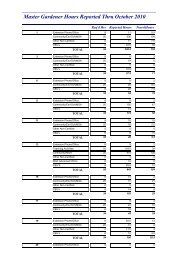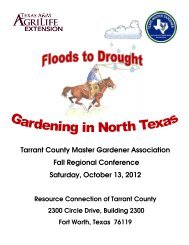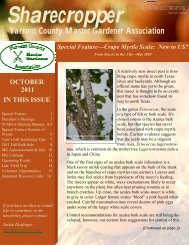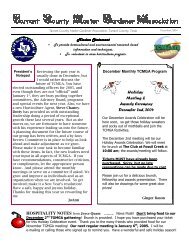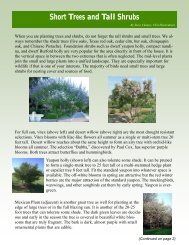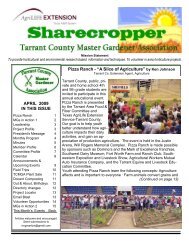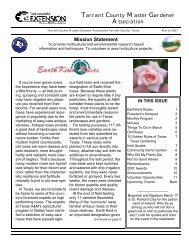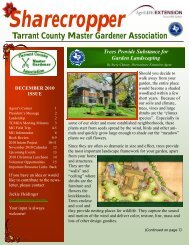Our Native Poinsettia Cousins - Tarrant County Master Gardener ...
Our Native Poinsettia Cousins - Tarrant County Master Gardener ...
Our Native Poinsettia Cousins - Tarrant County Master Gardener ...
Create successful ePaper yourself
Turn your PDF publications into a flip-book with our unique Google optimized e-Paper software.
Christmas <strong>Poinsettia</strong> is indigenous to Mexico, originating in a rather limited region near present<br />
day Taxco; but close cousins north of the border have their own special beauty and vibrancy. In<br />
particular, Texas has four native poinsettias that may have a place in your garden.<br />
But first, a little family history. Euphorbias are named after Euphorbus, a 1 st century physician<br />
and friend of King Juba II of Mauritania (52 BCE – 23 CE). But what makes the family so unusual<br />
is that they all have this peculiar flower structure called “cup-flower” or cyathium, and they<br />
are the only plants that have this unusual flower shape. Look closely at the cup-flower of any of<br />
the poinsettias and you’ll recognize what makes a Euphorbia so different. They also all share another<br />
family trait of a thick, milky sap that can be a skin irritant.<br />
The Christmas <strong>Poinsettia</strong> is only sold for the last six weeks of the year, but tens of millions of<br />
them filter through stores and nurseries to make it by far the best selling flowering plant in the<br />
United States. It was named for the first United States minister to Mexico, Joel Roberts Poinsett,<br />
who brought the plant to the U.S. in 1828, and sent them to President Andrew Jackson for a<br />
Christmas display at the White House, making it a Christmas tradition. The scientific name, Euphorbia<br />
pulcherrima, translates as “the most beautiful Euphorbia.”<br />
Texas natives<br />
<strong>Our</strong> <strong>Native</strong> <strong>Poinsettia</strong> <strong>Cousins</strong><br />
By Marilyn Sallee, <strong>Master</strong> <strong>Gardener</strong> & <strong>Native</strong> Plant Specialist<br />
The native euphorbia most deserving of cultivation and a place in the flower-bed is a close relative<br />
of pulcherrima. The Painted <strong>Poinsettia</strong>, Euphorbia<br />
cyathophora, has bracts that turn an intense<br />
day-glo orange-red, and the most amazing<br />
fiddle-shaped leaves. This annual re-seeds<br />
freely with seed capsules that throw the seeds a<br />
great distance when the capsule dries and bursts<br />
open.<br />
In the garden, Painted <strong>Poinsettia</strong> makes a tall<br />
background plant of deep green unusual-shaped<br />
leaves with the red bracts forming in mid summer.<br />
In the flowerbed rich soil can make it<br />
lanky and weak, causing it to lay down when<br />
wet. Keeping it a background plant gives some<br />
support from other plants to hold it upright. And<br />
The "painted poinsettia " Euphorbia cyathophora.<br />
(Photo by Marilyn Sallee)<br />
the intense red bracts around the cup-flowers is an eye-catcher – enough to give it another common<br />
name of Fire-on-the-mountain. Which leads us to another native poinsettia.<br />
(Continued on page 2)
<strong>Our</strong> <strong>Native</strong> <strong>Poinsettia</strong> <strong>Cousins</strong>—cont’d<br />
The next of the Texas native poinsettias is actually<br />
a pair of plants so closely related they<br />
are often mistaken for each other and even interbreed.<br />
Even their names are close – Snowon-the-mountain<br />
(Euphorbia marginata) and<br />
Snow-on-the-prairie (Euphorbia bicolor). At<br />
the end of summer,<br />
entire fields<br />
suddenly appear<br />
to be waist-deep<br />
in a lacy white<br />
blanket of snow.<br />
Both the small<br />
cup-flowers and<br />
bract edges are<br />
white.<br />
You can tell the<br />
“snows” apart by<br />
the leaf shape:<br />
marginata is<br />
broad-leafed and<br />
pointed (ovate)<br />
while bicolor has<br />
a long, narrow leaf with a rounded tip<br />
A field of Euphorbia bicolor<br />
(photo by Marilyn Sallee)<br />
(spatulate). They both have three-lobed seed<br />
capsules which fling the seeds when dry in<br />
fall. These are annuals whose seeds are worth<br />
gathering for a native garden.<br />
<strong>Our</strong> final Texas native, Euphorbia dentata, is a<br />
humble, unassuming little poinsettia. While its<br />
cousins can often be waist tall, dentata is usually<br />
about a foot tall. Its leaves are simple, lanceolate<br />
with toothed edges and well spaced up<br />
the stem. And while its cousins are quite<br />
showy when in bloom, dentata is subtle – the<br />
bracts near the green flower-cluster turn a<br />
powdery silver-white, much like the center of<br />
the plant has been dusted with powdered sugar,<br />
with green seedpods forming cleaved balls clustered<br />
in the center.<br />
And Euphorbia dentata can’t help but reveal a<br />
family secret in its common name – Toothed<br />
Spurge. Yes, all these poinsettias are spurges,<br />
usually considered weeds. But what are weeds<br />
but under-appreciated native plants. Painted<br />
Spurge, Snowy Spurge, Toothed Spurge – all deserve<br />
a place in a diverse native garden.<br />
Growing tips<br />
All need full sun to partial shade, in welldrained<br />
soil. Keep well watered but allow soil to<br />
dry between waterings. The plants are native to<br />
poor soils and do not need fertilizer or excessive<br />
water; too much water or fertilizer will provide<br />
lanky growth and few flowers. Collect seeds after<br />
the pods have fully formed, but before they<br />
dry and pop open.<br />
Euphorbia dentate<br />
(photo from Wikipedia)



